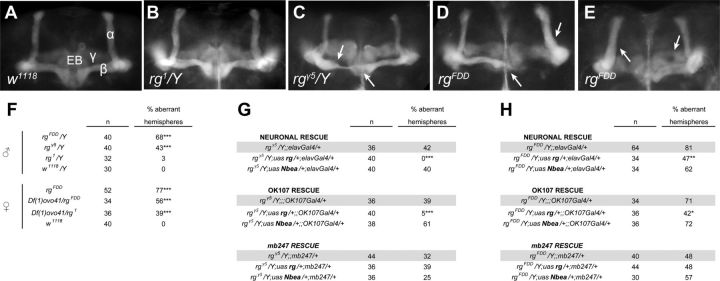Figure 4.
The morphological MB defects in rg mutants are genetically separable from the learning phenotype. Whole-mount anti-fasciclin II staining of the adult central brain labels α, β, γ MB lobes and the ellipsoid body (EB). A, Control w1118 MB lobes (α, β, γ) and EB. B, rg1 MBs show only minor defects compared with control brains. C, rgγ5 hemizygote with an aberrant morphology of the β lobe and β-lobe fusion. D, Overextension of the β lobe and full β-lobe misguidance in rgFDD brains. E, Full β misguidance and aberrant γ-lobe morphology of rgFDD MBs. MB defects mentioned for C–E are indicated with arrows. F–H, Quantification of the frequency of the morphological defects in rg mutants (F) and their respective rescues in rgγ5 (G) and rgFDD (H) background combined with a Gal4 driver. rgγ5 and rgFDD combined with the Gal4 driver were used as mutant controls (indicated in gray) to correct for effects of the Gal4 driver and genetic background. The rescues with the rugose transgene generally rescued the phenotypes completely or partially with, respectively, elav–Gal4 or the MB driver OK107–Gal4. Reintroducing rg+ cDNA with MB247–Gal4 had no effect. Nbea cDNA expression failed to rescue the phenotypes. Numbers represent the percentages of aberrant hemispheres. Fusion defects were counted as defects of two hemispheres. n is the number of brain hemispheres analyzed. Statistical significance between rgγ5 or rgFDD combined with a Gal4 driver and the respective rescues with transgenic rg+ or Nbea cDNA were assessed with the Fisher's exact test. For rugose mutants, statistical significance with w1118 brains was also assessed with the Fisher's exact test.

